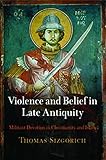Violence and Belief in Late Antiquity : Militant Devotion in Christianity and Islam / Thomas Sizgorich.
Material type: TextSeries: Divinations: Rereading Late Ancient ReligionPublisher: Philadelphia : University of Pennsylvania Press, [2012]Copyright date: ©2009Description: 1 online resource (408 p.)Content type:
TextSeries: Divinations: Rereading Late Ancient ReligionPublisher: Philadelphia : University of Pennsylvania Press, [2012]Copyright date: ©2009Description: 1 online resource (408 p.)Content type: - 9780812241136
- 9780812207446
- Identity (Psychology) -- Religious aspects -- Christianity
- Identity (Psychology) -- Religious aspects -- Islam
- Martyrdom -- Christianity
- Martyrdom -- Islam
- Violence -- Religious aspects -- Christianity
- Violence -- Religious aspects -- Islam
- Religious Studies
- RELIGION / History
- Ancient Studies
- History
- Religion
- Religious Studies
- 201/.7633209
- BT736.15 ǂb S57 2009eb
- online - DeGruyter
| Item type | Current library | Call number | URL | Status | Notes | Barcode | |
|---|---|---|---|---|---|---|---|
 eBook
eBook
|
Biblioteca "Angelicum" Pont. Univ. S.Tommaso d'Aquino Nuvola online | online - DeGruyter (Browse shelf(Opens below)) | Online access | Not for loan (Accesso limitato) | Accesso per gli utenti autorizzati / Access for authorized users | (dgr)9780812207446 |
Browsing Biblioteca "Angelicum" Pont. Univ. S.Tommaso d'Aquino shelves, Shelving location: Nuvola online Close shelf browser (Hides shelf browser)
Frontmatter -- CONTENTS -- INTRODUCTION -- CHAPTER ONE. “The Devil Spoke from Scripture”: Boundary Maintenance and Communal Integrity in Late Antiquity -- CHAPTER TWO. “The Living Voice of Kindred Blood”: Narrative, Identity, and the Primordial Past -- CHAPTER THREE. “What Has the Pious in Common with the Impious?” Ambrose, Libanius, and the Problem of Late Antique Religious Violence -- CHAPTER FOUR. “Are You Christians?” Violence, Ascetics, and Knowing One’s Own -- CHAPTER FIVE. “Horsemen by Day and Monks by Night”: Narrative and Community in Islamic Late Antiquity -- CHAPTER SIX. “The Sword Scrapes Away Transgressions”: Ascetic Praxis and Communal Boundaries in Late Antique Islam -- CHAPTER SEVEN. “Do You Not Fear God?” The Khāwarij in Early Islamic Society -- CHAPTER EIGHT. “This Is a Very Filthy Question, and No One Should Discuss It”: The Messy World of Ibn Ḥanbal -- CONCLUSION -- ABBREVIATIONS -- NOTES -- SELECT BIBLIOGRAPHY -- INDEX -- ACKNOWLEDGMENTS
restricted access online access with authorization star
http://purl.org/coar/access_right/c_16ec
In Violence and Belief in Late Antiquity, Thomas Sizgorich seeks to understand why and how violent expressions of religious devotion became central to the self-understandings of both Christian and Muslim communities between the fourth and ninth centuries. Sizgorich argues that the cultivation of violent martyrdom as a path to holiness was in no way particular to Islam; rather, it emerged from a matrix put into place by the Christians of late antiquity. Paying close attention to the role of memory and narrative in the formation of individual and communal selves, Sizgorich identifies a common pool of late ancient narrative forms upon which both Christian and Muslim communities drew.In the process of recollecting the past, Sizgorich explains, Christian and Muslim communities alike elaborated iterations of Christianity or Islam that demanded of each believer a willingness to endure or inflict violence on God's behalf and thereby created militant local pieties that claimed to represent the one "real" Christianity or the only "pure" form of Islam. These militant communities used a shared system of signs, symbols, and stories, stories in which the faithful manifested their purity in conflict with the imperial powers of the world.
Mode of access: Internet via World Wide Web.
In English.
Description based on online resource; title from PDF title page (publisher's Web site, viewed 08. Aug 2023)









